|
Classic Camera Collectors Club Informatif website of Frank Lakiere |
CHAPTER 1 : From Aristotle to Eastman.
1.1. Introduction
1.2. The camera obscura
1.3. The photochemical experiments
1.3.1. From Aristotle to the 18th century
1.3.2. The first photograph
1.3.3. The Daguerreotype
1.3.4. The calotype
1.3.5. The collodion process
1.3.6. The ambrotype process
1.3.7. The tintype process
1.3.8. The dry-plate
1.3.9. The flexible film
CHAPTER 2 : SOME VERY IMPORTANT PERSONS IN THE HISTORY OF PHOTOGRAPHY
CHAPTER 3 : Timeline
1.1. Introduction
The word 'photography' is derived from the Greek words for 'light' (photos) and 'write' (graphein).
Sir John Herschel was the first to use the term 'photography' in 1839, the year that the photographic processes of Daguerre and of Talbot were made public.
It is certainly worth mentioning that the French writer de la Roche (1729-1774) made a remarkable prediction in his work named 'Giphantie'. In this story he depicts a technique that can capture images from nature. On a canvas, that is covered with a sticky substance, an image is projected. This image is made permanent by drying the canvas in the dark.
The author certainly will not have suspected that only a few decades after his dead this science fiction story would become reality.
If you consider photography to be primarily a scientific invention it is certainly a mystery why it lasted until the 1830s before photography was invented.
The two techniques that are needed to get a photograph were already studied in extenso:
1. first you form an optical image in the camera
2. and then you have to chemically fix this image.
The camera obscura was already in use for hundreds of years and the light-sensitivity of several chemical substances had been known for a long time. But if you consider the development of the arts it all becomes clear. During the 18th century the painters of landscapes are trying more and more to render nature as real as possible. But not only in the paintings is the romanticism replaced by the realism. Paintings look more and more as perceptions of the eye and less as compositions that are made according to the a set rules. This new artistic vision is fully in line with the possibilities of the photography.
On a cultural base this is also a time that one searches for better education and schooling. And here the photography can help not as a technique that produces art, but as a reproduction technique to help in education and in the propagation of art and science.
The impulse of the industrial revolution also lead to the birth of photography. For, as in the industry manual labour was taken over by machinery, the same development took place regarding the reproduction of reality. In the photography light energy and chemical processes replace the painter. So photography was invented in this period because the scientific, historical, artistic, economic and cultural factors favoured this evolution.

1.2. The camera obscura
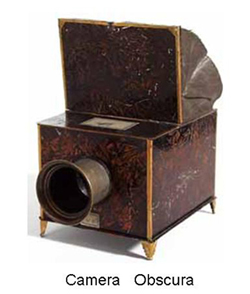
The camera obscura or dark room was already known for at least 400 years.
In 1519 Leonardo da Vinci describes how to use a camera obscura for the observation of eclipses of the sun.
In the book by Gemma Frisius 'Ratio astronomico et geometrico liber', edited by Plantijn in Antwerp in 1545, one can find a detailed description of the camera obscura that was used for the observation of the total eclipse on Januari 24th 1544 at Leuven.
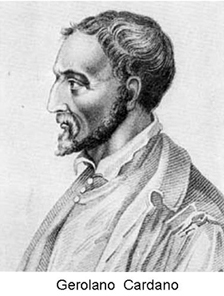 Gerolano Cardano, an Italian mathematician (1501-1576), mounted a convex lens
in his camera obscura (instead of the pinhole) and by doing so he obtained an image
that was much clearer.
Gerolano Cardano, an Italian mathematician (1501-1576), mounted a convex lens
in his camera obscura (instead of the pinhole) and by doing so he obtained an image
that was much clearer.Other descriptions of fixed as well as of movable dark rooms are made by Giovanni Battista della Porta (1558), Anastasius Kircher (1646), Johannes Sturm (1676) en Johannes Zahn (1685).
In this period the use of the camera obscura as a help tool for drawing perspective is wide-spread.
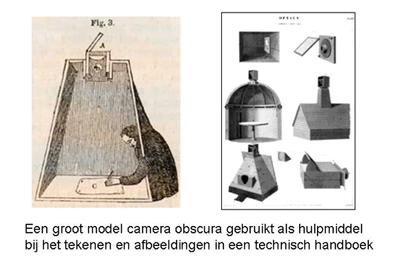
Daniël Barbaro from Venice wrote:
'Lock all doors and windows, until all the light is shut out, except for the light through the lens. Hold a piece of paper against this light and move it forwards or backwards until the image is as sharp as possible. On the paper you can see the whole view as it really is, with distances, colours, shades and movements, the clouds, the sparkling of the water, the flight of the birds. By keeping the paper still you can draw the total perspective and then colour the whole scene as natural as possible.'
Sometimes these early dark rooms were really huge.
It is told that Giovanni Battista della Porta had a dark room with seats for his guests. At the outside a group of actors was playing and the visitors could admire the images of the spectacle on the wall of the room. But seeing the actors, moving around upside down on the wall, the visitors got caught by panic and fled away. Della Porta was brought to justice and was accused of sorcery.

1.3. The photochemical experiments
1.3.1. From Aristotle to the 18th century
It was already known for many centuries that certain colours faded in the sunlight, although the difference between the influence of light, warmth and air was not especially made.
In the 16th century Robert Boyle (founder of the Royal Society) reported the fact that silver chloride darkened when it was left in the open. However he believed that the darkening was caused by the exposure of the silver chloride to air, rather than by the action of the light.
Johann Heinrich Schulze (1687-1744) discovers the light sensitivity of silver salts in 1727.
During his chemical experiments, he dissolved chalk in nitric acid, which eventually contained some silver nitrate. When he regarded the sediment after a while, he saw that the side that was turned towards the light was dark, while the backside was still unchanged. He went on searching and could demonstrate that the darkening was not caused by the heat rays but that it had to be the action of the light rays.
This led to the following experiment : on a bottle filled with silver nitate-chalk sediment Schulze glued some characters cut out of dark paper. After exposition to sunlight a negative image of the characters was formed in the sediment.
This experiment (published in 1727) is an important step in the evolution of the photography, although Schulze did not have any idea on how he could make that image permanent.
In the beginning of the 19th century Thomas Wedgwood and Humphry Davy have executed experiments whereby they successfully captured images, but they also did not find a method to keep them permanent.
There is a direct link from Schulze to Wedgwood and Davy and finally to Talbot , who may be called the inventor of the modern photography.
1.3.2. The first photograph
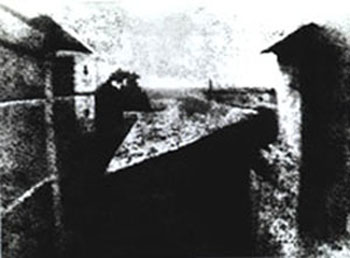 It lasted until 1826 before the first successful attempt was made to produce a
permanent photograph. At Saint-Loup-sur-Varennes, near Chalon-sur-Saône,
Nicéphore Niépce made an
image of the buildings he saw from his room. He used a kind of light sensitive asphalt (Jodenasfalt or
Indea bitumen). The time of exposure was not less than 8 hours!!
Not exactly a technique to produce a portrait.
It lasted until 1826 before the first successful attempt was made to produce a
permanent photograph. At Saint-Loup-sur-Varennes, near Chalon-sur-Saône,
Nicéphore Niépce made an
image of the buildings he saw from his room. He used a kind of light sensitive asphalt (Jodenasfalt or
Indea bitumen). The time of exposure was not less than 8 hours!!
Not exactly a technique to produce a portrait.During the same year Niépce also invented the heliography. He took a tin plate with a layer of bitumen on it and on top of it he placed a paper with a drawing. Then he exposed the plate. The bitumen that was not exposed to the light was not hardened and could be dissolved. After that the plate could be etched and could be used to make prints.
The technique with bitumen has not lead to the modern photography. But it still an important technique, because it was developed further by Abel Niépce de St-Victor, a nephew of Nicéphore Niépce. In 1853 he published 'Traité pratique de gravure héliographique sur acier et sur verre' and together with the gelatine-bichromate method of Talbot this forms the basis of the modern photogravure.

1.3.3. The daguerreotype
 On January 4th, 1829 Niépce
and Daguerre came to an agreement on
co-operation in their search for a photographic procedure.
On January 4th, 1829 Niépce
and Daguerre came to an agreement on
co-operation in their search for a photographic procedure.Four years later Niépce died without having seen much progress, but Daguerre went on searching and he eventually discovered a way to develop the image formed on silver chloride by means of mercury vapour. This made it possible to reduce the exposure time to half an hour.
Daguerre also discovered the way to fix the developed image by washing the plate in a solution of salt.
This was the birth of the daguerreotype.
By July 1839 the rights on the discovery were bought by the French Government and on August 19th of the same year, the procedure was given to the world. But still Daguerre succeeded in patenting his invention in England just 5 days earlier.
The reactions were overpowering, but not everybody was reacting positively.
An article in a city paper in Leipzig stated:
' ... to wish to capture volatile reflections and make them permanent, is not only impossible... but the wish alone, the will to do this, is blasphemous.
God has made men to His own image and a man made machine may not capture the image of God.
Is it possible that God would drop His eternal principles and allow a Frenchman... to give the world an invention of the Devil?'
Some painters, especially painters of miniature portraits, saw the photography threatening their existence. Some of them even predicted that the art of painting would cease to exist.
The daguerreotype technique gave good results, but there were two major drawbacks: a photograph was rather expensive and
there was only one specimen of every photograph.
Not everyone saw that as a drawback because this also meant that the owner of a daguerreotype portrait as sure of having a unique work of art that could not be copied several times.
On the other hand, when two or more copies were needed, one had to use several cameras or one had to repeat the session several times.
There was such a great demand for copies that it was impossible for the daguerreotype to cope with it.

1.3.4. The calotype
The calotype, invented by William Fox Talbot, was a totally different technique. Op January 31st, 1839, so even before the publication of Daguerre, Talbot sends an article to the Royal Society in London. The article is entitled: 'Some account of the art of photogenic drawing, or the process by which natural objects may be made to delineate themselves without the aid of the artist's pencil.
He wrote:
' How wonderful would it be if it would be possible to make that these images of nature reproduced themselves and stayed fixed on the paper!'
The first known paper negative that we know of is made in august 1835. It is an image of the famous window at Lacock Abbey, where Talbot lived.
 The negative is very small (1 square inch i.e. 2.54 x2.54 cm) and the quality
is not very good. But by the end of 1840 Talbot already had made many improvements.
The negative is very small (1 square inch i.e. 2.54 x2.54 cm) and the quality
is not very good. But by the end of 1840 Talbot already had made many improvements.The quality of the first calotypes is certainly less compared to the daguerreotypes, but the major advance of the method of Talbot was that there could be made numerous positive prints of one negative. Despite all its great qualities, the daguerreotype was a dead end street. The principles of the calotype technique form the base of modern photography.
The negatives made by Talbot had paper as base. The defects in the paper negative were printed along with the proper image. A lot of research was done to use glass as a support for the negative material, but the problem was that there was no possibility to make the silver chloride adhere to the smooth glass surface.
Abel Niépce de Saint-Victor perfected the albumen (white of egg) process in 1848. A glass plate was covered with a layer of albumen and then made sensitive with potassium iodide and an acid solution of silver nitrate.
This technique gave much better results with very fine detail, but the film was very slow and so it could be used only for landscape and architectural photography. To make a portrait with this plates was simply impossible.

1.3.5. The collodion process
Frederic Scott Archer was not happy with the unsharp images of the calotype, due to the fibrous structure of the paper. He thus switched to the albumen method, but he replaced the albumen by collodion. In 1851 he finally succeeded in shortening the exposure time to a few seconds and so opened new horizons for the photography.
The collodion process used glass plates as support and these had to remain wet during the whole procedure (applying the sensitive layer, exposure and development). The photograph thus had to carry along with him a lot of material: a camera, heavy glass plates, a black tent to work in, tanks for holding the several liquids for sensibilisation, development and fixing.
There were also made attempts to keep the exposed glass plates in collodion solutions and then develop them later, but this diminished the sensitivity of the plates.
1.3.6. The ambrotype process
The ambrotype is a special application of the collodion technique. It was developed to get direct positive images in the camera.
Ambrotype uses a collodion negative, under-exposed en subsequently bleached. When mounting this negative against a black background (black velvet) the image seems to be positive in those places where there is still silver that reflects the light. The places where silver is totally absent look black.
Ambrotypes were made during the period 1850 - 1890 and although they do have a certain resemblance with daguerreotypes the production technique is essentially different.
The great popularity was caused by the lower cost of the ambrotypes. But there were a few other advantages:
- a short exposure time
- by mounting the negative back to front a correct image was formed and not a reversed image as in most daguerreotypes.
- a better visibility under all angles of vision then with daguerreotypes
A variant of this technique was the tintype process.
1.3.7. The tintype process
This process is also called ferrotype. It is avarian of the ambrotype and it was invented in 1852 by Adolphe Alexandre Martin (1826-1892).
A tin-coated iron plate is lacked in black with a mixture of linseed oil, lamp-black (soot) and asphalt. Above this layer comes the collodion.
The ferrotype replaced the ambrotype within a very short time, because the iron plates were less fragile and thus easier to handle.

1.3.8. The dry plate
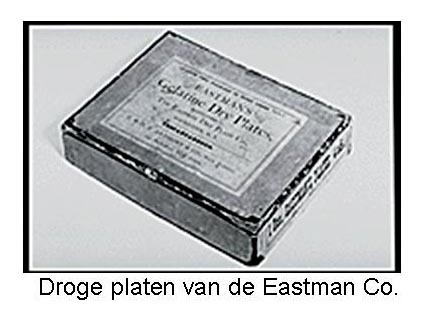
A dry-plate process had to bring the solution.
Richard Maddox discovered in 1871 a method to use gelatine instead of collodion.
At first the dry-plates were less sensitive then the existing techniques, but the process was made better and eventually it was possible to think about industrially made photographic material.
How difficult it must have been to produce a practical and sensitive dry-plate is demonstrated by the fact that in 1862 the Photographic Society of Marseille offered a reward of 500 Francs for '... a dry-plate process that can produce a photograph of a street scene in full sunlight, including action and movement.'
The sensitivity of the plates was raised by adding all kinds of chemicals: like tannin, Gallic acid, pyrogallic acid, citric acid, ammonia, etc...
In 1863 Major C. Russell publishes 'The Tannin Process', an article in which he describes his experiments with alcalic developers and the use of excess potassium bromide.
This was the base for the development of the modern silver bromide emulsions and the until now used alcalic developers.
And so the day came near that it became possible that someone without any specific knowledge on the technique of photography could make his own photographs.
1.3.9. The flexible film
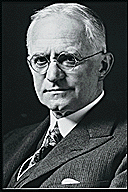
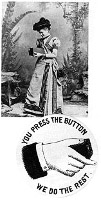
Photography evantually was made available for everybody by the genius of George Eastman, the founder of KODAK.
He introduced the flexible film on celluloid base in 1884
In 1888 he marketed his KODAK box camera with the slogan: 'You push the button, we do the rest'.
And with the invention of the roll film in a daylight loading cassette, the photography could finally begin her unstoppable advance.
